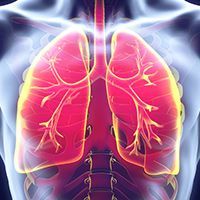Modest Budget Effects Demonstrate Promise for Uptake of Genomic Profiling in NSCLC
The identification of actionable oncogenetic drivers in patients with non–small cell lung cancer affords clinicians the opportunity to use targeted agents to optimize outcomes.
Lung Cancer Image

The identification of actionable oncogenetic drivers in patients with non–small cell lung cancer (NSCLC) affords clinicians the opportunity to use targeted agents to optimize outcomes. The uptake of comprehensive genomic profiling (CGP) has not seen huge uptake in community practice. Results of a real-world study showed that 37% of patients within the US Oncology Network with NSCLC (N = 3474) underwent next-generation sequencing.1
Although investigators noted that the rates of next-generation sequencing increased over the 2-year study period, comprehensive testing for the 5 prominent biomarkers in NSCLC was only 46%.1
Results of a budget impact analysis published in JCO Precison Oncology may alievate some of the cost concerns surrounding the use of CGP in the clinic.2 Investigators developed a decision analytic model to estimate associated benefits and costs that may arise with CGP vs conventional testing strategies. “Compared with nonCGP approaches, CGP provides more information to guide treatment decisions at a modest increased cost,” the authors wrote. “Testing costs were [less than] 1% of the total cost of care in base-case scenarios. Shifting to CGP increased the use of targeted therapies and reduced the use of chemoimmunotherapies, affording a more efficient use of resources.”
Rationale for Bringing Testing to Practice
The National Comprehensive Cancer Network (NCCN) guidelines for patients with NSCLC recommend that all eligible patients receive broad molecular profiling to identify drive mutations and optimize treatment strategies. According to the documentation, broad molecular profiling is defined as molecular testing that identifies alterations in EGFR, ALK, ROS1, BRAF, NTRK, HER2, MET, RET, and KRAS in either a single assay or a combination of a limited number of assays. Though not required, the NCCN recommends using approaches that may also identify emerging biomarkers including high-level MET amplification and HER2mutations.3
The guidelines provide a comprehensive overview of the recommended therapeutic options available should patients demonstrate any of the actionable mutations with documented benefit compared with traditional chemotherapy regimens.
In the budget analysis, investigators defined CGP approaches to include next-generation sequencing assays that detect novel and known variants of the 4 main classes of genomic alterations ( and genomic signatures in tumor tissue or circulating tumor DNA (ctDNA) assays. Conventional approaches included tissue-based panel tests for known NSCLC genomic alterations, single-gene tissue-based, or ctDNA-based hotspot tests for alterations in EGFR or ALK. Investigators noted that conventional approaches are often used sequentially and can be time-consuming and demanding on patients as they require multiple biopsies.2
The model was based on a hypothetical 2-million member US health plan population, constructed to reflect a population of individuals from 2016. Specifically, investigators looked to assess outcomes for patients with newly diagnosed NSCLC following CGP-based testing vs nonCGP testing from the perspective of a US commercial payer. Cost of care and overall survival (OS) were the primary outcome measures.
Cost-related outcomes considered costs for diagnostic testing, biopsies, blood draws, first-line treatment, administration, health resource utilization, and biopsy- and drug-related adverse effects. Survival outcomes were based on treatments received following a patient being matched to a therapeutic class based on molecular results. These included targeted therapies, immunotherapies, nonmatched targeted therapies, chemoimmunotherapies, chemotherapy, treatments received in clinical trials, and no drug treatment.
Of the 790 members were expected to receive a new diagnosis of NSCLC, 609 were estimated to undergo molecular diagnostic testing; 545 received tissue-based testing and 64 received liquid-based testing. An estimated 122 patients had CGP with 109 undergoing tissue-based testing and 13 undergoing liquid-based testing. Per patient drug costs were projected to be $237,403 and the total cost of care estimated to be $325,548.2
Investigators concluded that if testing rates among patients increased from 20% to 30%, which added an additional 61 patients to receive testing, the per patient drug cost would increase $321 and the total care cost would increase $205. Overall, this increase in testing would have a “relatively small incremental budget” effect of $0.005 per member per month.
“Targeted therapies were associated with lower medical service expenditures than other categories of drug therapy; the increase in costs associated with testing was offset by this reduction in costs associated with medical services (–$253),” the authors wrote in a discussion of the analysis. “Although total costs increased as a result of more testing with CGP, the overall costs associated with testing ($2,186) were [less than] 1% of the total cost of care ($325,753) and were offset by a reduction in [health resource utilization] associated with more treatment with targeted therapy.”
In terms of survival outcomes, investigators determined that to add 1 life year, 19.6 patients would need to be tested with CGP vs nonCGP approaches. With the expansion of CGP testing, an additional 3.11 life-years—3.02 attributed to tissue-based testing and 0.1 attributed to liquid-based testing—were added.
“Identifying these genomic alterations is crucial for making optimal treatment decisions because the growing number of effective therapies that target driver oncogenes is continuously changing the paradigm for aNSCLC treatment,” the authors added. “Target-specific therapies have the ability to significantly improve response to treatment and progression-free survival compared with therapeutic regimens that do not target a specific alteration.”
References
- Robert NJ, Nwokeji ED, Espirito JL, et al. Biomarker tissue journey among patients (pts) with untreated metastatic non-small cell lung cancer (mNSCLC) in the U.S. Oncology Network community practices. J Clin Oncol. 2021;39(suppl 15):9004. doi:10.1200/JCO.2021.39.15_suppl.9004
- Harvey MJ, Cunningham R, Sawchyn B, et al. Budget impact analysis of comprehensive genomic profiling in patients with advanced non–small-cell lung cancer. JCO Precis Oncol. 2021;5:1611-1624. doi:10.1200/PO.20.00540
- NCCN. Clinical Practice Guidelines in Oncology. Non-small cell lung cancer, version 1.2022. Accessed January 19, 2022. https://www.nccn.org/professionals/physician_gls/pdf/nscl.pdf



